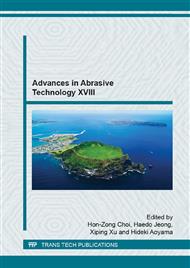p.215
p.221
p.227
p.233
p.239
p.245
p.251
p.257
p.265
Effect of Diamond Coating on Drilling Force and Temperature during High Speed Micro Drilling of Bone
Abstract:
Bone drilling commonly exists in clinical practice and the heat and force generated by the drilling process has a huge impact on the surgery effect and the recovery of patients. High speed drilling, proved to have less injury and be more efficient when compared to the traditional low speed drilling, is considered to be the development direction of bone drilling-related surgeries. In order to make a further study of the controlling of the heat and force during the bone drilling process, the experiment designed to examine the influence of the diamond coating has been conducted and the result indicates that the diamond coating generally has little influence on the drilling force, however, it can increase the drilling temperature to a certain extent which indicates that the diamond coating is not suitable to apply to bone drills under the conditions of the conducted experiments. The result of this research could be of some help to the development of new kinds of medical drills.
Info:
Periodical:
Pages:
239-244
Citation:
Online since:
January 2016
Authors:
Price:
Сopyright:
© 2016 Trans Tech Publications Ltd. All Rights Reserved
Share:
Citation:


